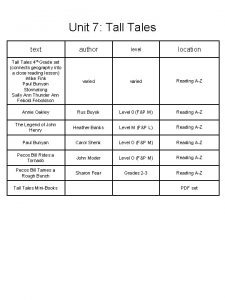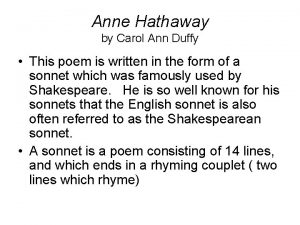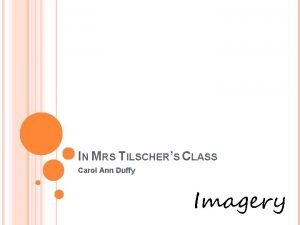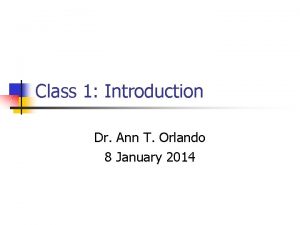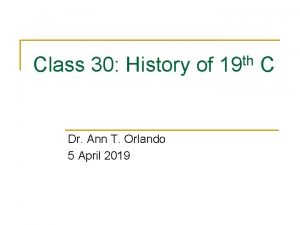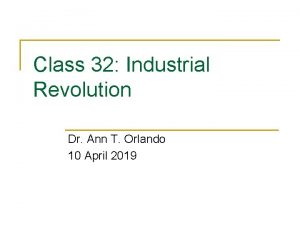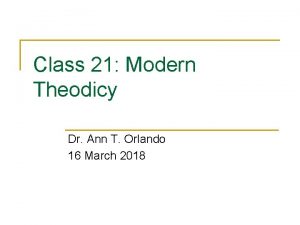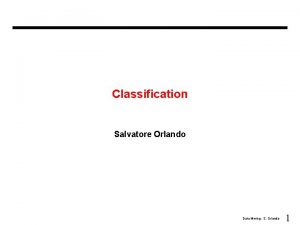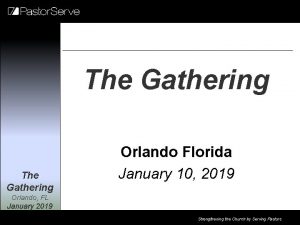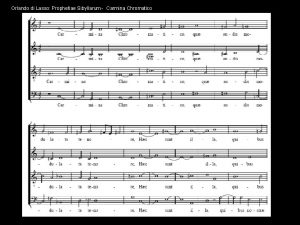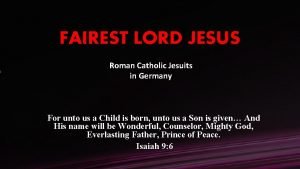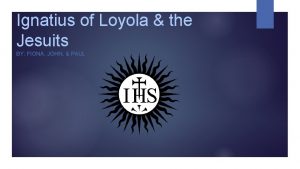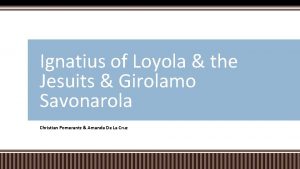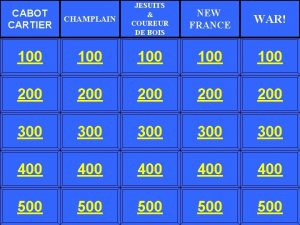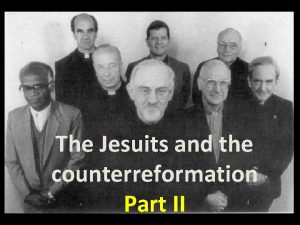Class 10 The Jesuits Dr Ann T Orlando


















- Slides: 18

Class 10: The Jesuits Dr. Ann T. Orlando 6 February 2019

Introduction n n Ignatius Loyola Founding of Jesuits Relation to Papacy Education Arts

Ignatius Loyola (1491 -1556); Founder of a New Order n n Minor courtier and officer in army; 1521 severely wounded defending Pamplona from French During recovery in Loyola started reading New Testament and Lives of Saints (nothing else to read!) q q q n Decided to return to school, study for priesthood; first at Alcala then at Salamanca q n n Imprisoned by Inquisition several times for teaching without being licensed Traveled to University of Paris to continue studies q n Once recovered, traveled to Montserrat where he left his sword and gave away his clothes to poor Lived in a cave near Manresa; had a series of enlightening visions Briefly went to Holy Land Shared rooms with Francis Xavier, Peter Faber Gathered a group of six, Company of Jesus, and Ignatius directed them in Spiritual Exercises Traveled to Rome and put themselves at disposal of Pope; approval of order given by Pope Paul III in 1540 Lived in Rome remainder of his life as Director General of Jesuits, by now a world-wide order Canonized with Francis Xavier by Pope Gregory XV in 1622

Jesuit Spirituality n n n Like Luther, Ignatius was overwhelmed by the profound sense of his own sin Like Luther, does not believe that being a monk is a guarantee of salvation But unlike Luther, believes that salvation is found by devotion to society of Church and her mission q q n n n Devotion includes attacking corruption Society includes those below and saints above Emphasis on engaging mind and emotions Emphasis on critical self-analysis Call to action and commitment

The Jesuits n NOT founded to counter Reformation; but charter put Jesuits on front lines against Reformers q n Education very important in Jesuit mission q n n Initially sent to Palestine as missionaries Children and adults Jesuits very focused on work among people Jesuit life-style in many ways opposite that of a monastery q Focus on action in world, rather than contemplation in monastery

Key Points of Jesuit Charter (1541) n n n Vow not to accept ecclesiastical dignities; Special relationship to Pope Increased probations. q q q n n n The novitiate is prolonged from one year to two, A third year, which usually falls after priestly ordination. Candidates at first admitted to simple vows only, solemn vows coming much later on; The Society does not keep choir; It does not have a distinctive religious habit; It is also said to have been the first order to undertake officially and by virtue of its constitution active works such as the following: n n n foreign missions, at the pope's bidding; the education of youth of all classes; the instruction of the ignorant and the poor;

Jesuits and Papacy n n n Jesuits become the Pope’s ‘Marines’ Missionaries on voyages of discovery Intellectual leaders in Vatican Supported new learning, new artistic techniques, in service of renewed Catholic spirituality Spearheaded a new Catholic confidence q q Saints Religious Art Penance Indulgences (properly understood)

Jesuit Education n First school (college) opened in Messina, Sicily in 1548 In Europe by 1560, Jesuits were running 30 primary schools and had established the Roman College (Gregorian) Jesuit educational mission q q n Education, in broadest sense, becomes primary mission Established new educational institutions at all levels Purpose of these institutions was to train men for a career in the world Academic research was a hallmark of Jesuit education (e. g. St. Peter Clavier) Major Jesuit colleges have printing press and extensive library q World-wide

The Parisian System of Education n System being developed in Paris, which Ignatius and other members of the Company experience But Jesuits make it their own and so completely propagate it around the word that ‘the Paris system’ formed the basis for modern education Elements of the Parisian system q q n Students divided into classes Progress based on a graduated system Active learning: writing and speaking Standardized program of instruction See letter 24 describing colleges to be established in Germany

Jesuits and the Arts n n ‘Hands’ approach to education extended to crafts and arts Jesuits become intellectual sponsors of Baroque artistic movement q q n Expressed in society Encouraged a heightening of religious feeling and sentiment Jesuit colleges important in performance arts, especially theater q Opportunity for young students to learn poise, diction and how to ‘act’ in society

Baroque Art n In some ways fueled by Jesuit spirituality q q n Emphasis on emotions and physical Church of Gesu, first Baroque Church Also fueled by reaction against Protestant views q q Importance of Saints Importance of images for devotion

Church of the Gesu n n Located on site that Ignatius of Loyola selected for his Roman headquarters Dedicated in 1584 after 40 years of construction and 6 architects including Michelangelo Mother Church for Jesuits Model for Jesuit churches throughout the world

Baroque n n n Massive urban renewal of Rome Spectacular building projects, most of them religious Primary artists q q Francesco Borromini (1599 -1667) Gianlornezo Bernini (1598 -1680)

Borromini’s Rome

Bernini’s Rome n n n Fountains Sculptures Churches

The Ultimate Statement of Baroque: St. Peter’s n Note the list of great artists who worked on new St. Peter’s: q q n Alberti Bramanate Della Porta Michelangelo But the final driving force to bring the entire monumental work to completion: Bernini

From Cupola Looking to Chair of St. Peter

Assignments n 1. Ignatius Loyola Spiritual Exercises, Rules to Have True Sentiment in the Church available at http: //www. fordham. edu/halsall/source/loyolaspirex. html
 Tall tale characters
Tall tale characters Anne hathaway sonnet
Anne hathaway sonnet In mrs tilscher's class annotated
In mrs tilscher's class annotated Hát kết hợp bộ gõ cơ thể
Hát kết hợp bộ gõ cơ thể Bổ thể
Bổ thể Tỉ lệ cơ thể trẻ em
Tỉ lệ cơ thể trẻ em Gấu đi như thế nào
Gấu đi như thế nào Glasgow thang điểm
Glasgow thang điểm Bài hát chúa yêu trần thế alleluia
Bài hát chúa yêu trần thế alleluia Môn thể thao bắt đầu bằng chữ đua
Môn thể thao bắt đầu bằng chữ đua Thế nào là hệ số cao nhất
Thế nào là hệ số cao nhất Các châu lục và đại dương trên thế giới
Các châu lục và đại dương trên thế giới Cong thức tính động năng
Cong thức tính động năng Trời xanh đây là của chúng ta thể thơ
Trời xanh đây là của chúng ta thể thơ Mật thư tọa độ 5x5
Mật thư tọa độ 5x5 Phép trừ bù
Phép trừ bù độ dài liên kết
độ dài liên kết Các châu lục và đại dương trên thế giới
Các châu lục và đại dương trên thế giới
